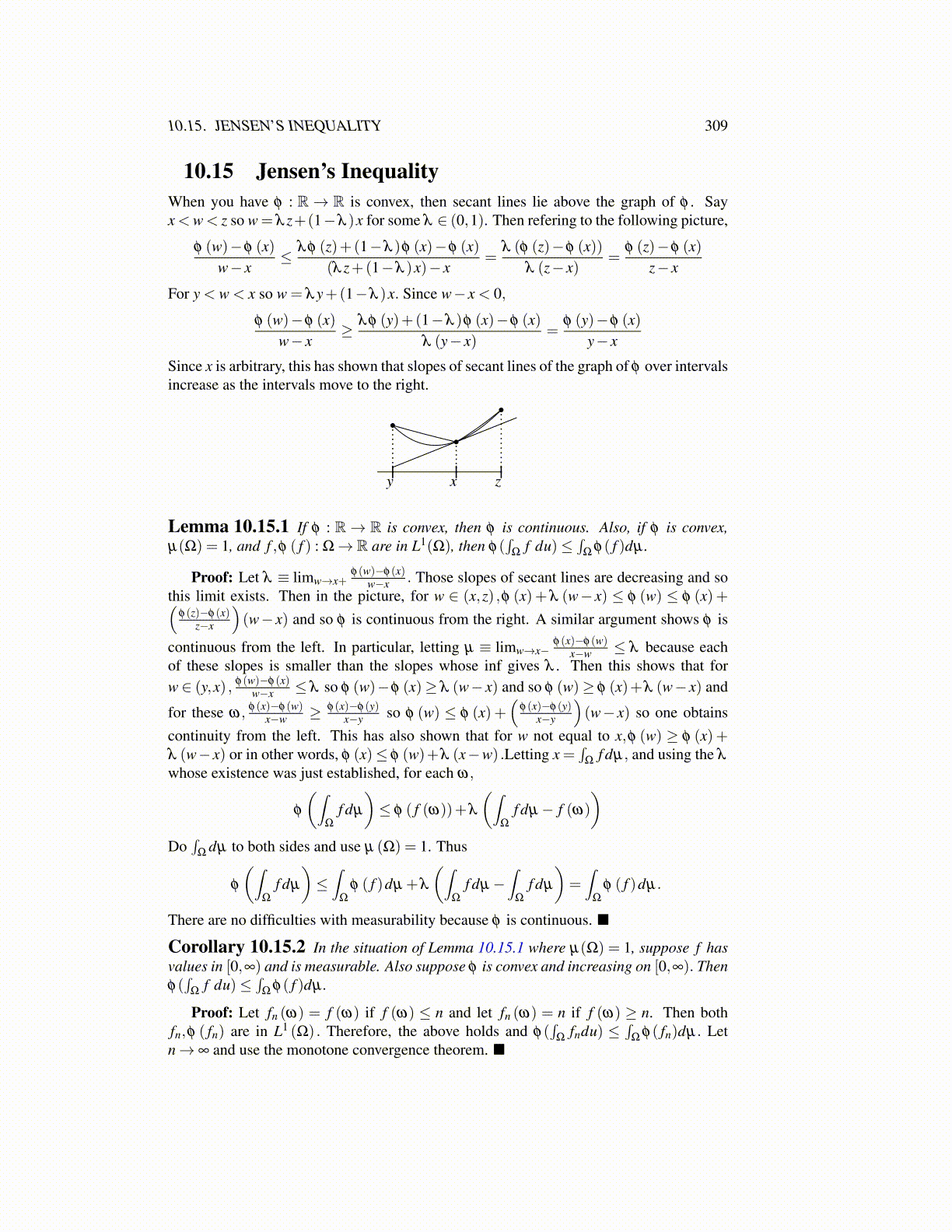
10.15. JENSEN’S INEQUALITY 309
10.15 Jensen’s InequalityWhen you have φ : R→ R is convex, then secant lines lie above the graph of φ . Sayx < w < z so w = λ z+(1−λ )x for some λ ∈ (0,1). Then refering to the following picture,
φ (w)−φ (x)w− x
≤ λφ (z)+(1−λ )φ (x)−φ (x)(λ z+(1−λ )x)− x
=λ (φ (z)−φ (x))
λ (z− x)=
φ (z)−φ (x)z− x
For y < w < x so w = λy+(1−λ )x. Since w− x < 0,
φ (w)−φ (x)w− x
≥ λφ (y)+(1−λ )φ (x)−φ (x)λ (y− x)
=φ (y)−φ (x)
y− x
Since x is arbitrary, this has shown that slopes of secant lines of the graph of φ over intervalsincrease as the intervals move to the right.
y x z
Lemma 10.15.1 If φ : R→ R is convex, then φ is continuous. Also, if φ is convex,µ(Ω) = 1, and f ,φ ( f ) : Ω→ R are in L1(Ω), then φ(
∫Ω
f du)≤∫
Ωφ( f )dµ .
Proof: Let λ ≡ limw→x+φ(w)−φ(x)
w−x . Those slopes of secant lines are decreasing and sothis limit exists. Then in the picture, for w ∈ (x,z) ,φ (x)+ λ (w− x) ≤ φ (w) ≤ φ (x)+(
φ(z)−φ(x)z−x
)(w− x) and so φ is continuous from the right. A similar argument shows φ is
continuous from the left. In particular, letting µ ≡ limw→x−φ(x)−φ(w)
x−w ≤ λ because eachof these slopes is smaller than the slopes whose inf gives λ . Then this shows that forw ∈ (y,x) , φ(w)−φ(x)
w−x ≤ λ so φ (w)−φ (x)≥ λ (w− x) and so φ (w)≥ φ (x)+λ (w− x) and
for these ω, φ(x)−φ(w)x−w ≥ φ(x)−φ(y)
x−y so φ (w) ≤ φ (x) +(
φ(x)−φ(y)x−y
)(w− x) so one obtains
continuity from the left. This has also shown that for w not equal to x,φ (w) ≥ φ (x) +λ (w− x) or in other words, φ (x)≤ φ (w)+λ (x−w) .Letting x =
∫Ω
f dµ, and using the λ
whose existence was just established, for each ω,
φ
(∫Ω
f dµ
)≤ φ ( f (ω))+λ
(∫Ω
f dµ− f (ω)
)Do
∫Ω
dµ to both sides and use µ (Ω) = 1. Thus
φ
(∫Ω
f dµ
)≤∫
Ω
φ ( f )dµ +λ
(∫Ω
f dµ−∫
Ω
f dµ
)=∫
Ω
φ ( f )dµ.
There are no difficulties with measurability because φ is continuous. ■
Corollary 10.15.2 In the situation of Lemma 10.15.1 where µ(Ω) = 1, suppose f hasvalues in [0,∞) and is measurable. Also suppose φ is convex and increasing on [0,∞). Thenφ(∫
Ωf du)≤
∫Ω
φ( f )dµ .
Proof: Let fn (ω) = f (ω) if f (ω) ≤ n and let fn (ω) = n if f (ω) ≥ n. Then bothfn,φ ( fn) are in L1 (Ω) . Therefore, the above holds and φ(
∫Ω
fndu) ≤∫
Ωφ( fn)dµ. Let
n→ ∞ and use the monotone convergence theorem. ■